Festive Pollution: A Global Concern—A Comparative Study of Diwali in India and New Year’s Eve in Poland
Abstract
1. Introduction
2. Materials and Methods
2.1. Ambient Air-Monitoring Location, Schedule, and Meteorological Data
2.1.1. Diwali Celebrations in Malda, West Bengal, India (2023 and 2024)
2.1.2. Quality Assurance and Quality Control
2.1.3. New Year Celebrations in Warsaw, Poland, Europe (2024)
2.1.4. Meteorological Parameters
2.1.5. Air-Quality Index (AQI)
2.2. Noise-Level Monitoring
2.3. Elemental Characterization
2.4. Health-Risk Assessment Due to Short-Term Exposure
CDIing = (C × IngR × EF × ED × CF)/(AT × BW)
ECinh = (Cv × ET × EF × ED)/ATn
2.5. Enrichmrnt Factor (EF) Analysis
2.6. Statistical Analysis
3. Results and Discussion
3.1. Air-Quality Monitoring During Festivities
3.1.1. Diwali
3.1.2. New Year
Diurnal Variation
3.2. Meteorological Attributes Influencing Pollution
3.2.1. Wind-Rose Plot
3.2.2. Backward Trajectory
3.3. Air Quality Index
3.4. Assessment of Noise Pollution
3.5. Elemental Composition of PM
3.6. Health-Risk Assessment
3.7. Enrichment Factor Analysis
4. Conclusions
Author Contributions
Funding
Institutional Review Board Statement
Informed Consent Statement
Data Availability Statement
Acknowledgments
Conflicts of Interest
References
- Kotnala, G.; Kumar, M.; Sharma, A.K.; Dhaka, S.K.; Gadi, R.; Ghosh, C.; Saxena, M.; Sharma, S.K.; Saha, A.R.; Nautiyal, A.; et al. Variations in chemical composition of aerosol during Diwali over mega city Delhi, India. Urban Clim. 2021, 40, 100991. [Google Scholar] [CrossRef]
- Yusuf, T.G.; Ikusemiju, T.M.; Habeeb, A.S. Perception of Awon Mass Wedding Festival by Contemporary Shao Community of Kwara State, Nigeria. Int. J. Herit. Tour. Hosp. 2020, 14, 52–60. [Google Scholar] [CrossRef]
- Chanchpara, A.; Muduli, M.; Prabhakar, V.; Madhava, A.K.; Thorat, R.B.; Haldar, S.; Ray, S. Pre-to-post Diwali air quality assessment and particulate matter characterization of a western coastal place in India. Environ. Monit. Assess. 2023, 195, 413. [Google Scholar] [CrossRef] [PubMed]
- Pratap, V.; Saha, U.; Kumar, A.; Singh, A.K. Analysis of air pollution in the atmosphere due to firecrackers in the Diwali period over an urban Indian region. Adv. Space Res. 2021, 68, 3327–3341. [Google Scholar] [CrossRef]
- Tanda, S.; Ličbinský, R.; Hegrová, J.; Goessler, W. Impact of New Year’s Eve fireworks on the size resolved element distributions in airborne particles. Environ. Inter. 2019, 128, 371–378. [Google Scholar] [CrossRef]
- Pervez, S.; Chakrabarty, R.K.; Dewangan, S.; Watson, J.G.; Chow, J.C.; Matawle, J.L. Chemical speciation of aerosols and air quality degradation during the festival of lights (Diwali). Atmos. Pollut. Res. 2016, 7, 92–99. [Google Scholar] [CrossRef]
- Brandhuber, P.; Clark, S.; Morley, K. A review of perchlorate occurrence in public drinking water systems. J. Am. Water Works Assoc. 2009, 101, 63–73. [Google Scholar] [CrossRef]
- Wu, Q.; Zhang, T.; Sun, H.; Kannan, K. Perchlorate in tap water, groundwater, surface waters, and bottled water from China and its association with other inorganic anions and with disinfection byproducts. Arch. Environ. Contam. Toxicol. 2010, 58, 543–550. [Google Scholar] [CrossRef]
- Liu, J.; Chen, Y.; Chao, S.; Cao, H.; Zhang, A. Levels and health risks of PM2. 5-bound toxic metals from firework/firecracker burning during festival periods in response to management strategies. Ecotoxicol. Environ. Saf. 2019, 171, 406–413. [Google Scholar] [CrossRef]
- Hu, U.; Sun, Y.; Yang, G.; Liu, M.; Gao, Y.; Lin, L.; Li, Q. Spring Festival Firework Activities Exacerbate Toxic Effects of Aerosol Essential Components. J. Hazard. Mat. 2025, 490, 137874. [Google Scholar] [CrossRef]
- Mehra, S.; Mawari, G.; Kumar, N.; Daga, M.K.; Singh, M.M.; Joshi, T.; Gargava, P.; Bhattacharjee, M.; Shukla, V.; Jha, M.K.; et al. Ecofriendly (green) firecrackers vs old firecrackers and their health effects: A systemic review. Atmos. Poll. Res. 2022, 41, 1095–1105. [Google Scholar] [CrossRef]
- Moffett, D.; Smith-Simon, C.; Stevens, Y.W. Toxicological Profile for Barium and Barium Compounds; United States Department of Health and Human Services: Washington, DC, USA, 2007; pp. 1–184. Available online: https://stacks.cdc.gov/view/cdc/6955/cdc_6955_DS1.pdf (accessed on 8 February 2024).
- Singh, A.; Pant, P.; Pope, F.D. Air quality during and after festivals: Aerosol concentrations, composition and health effects. Atmos. Res. 2019, 227, 220–232. [Google Scholar] [CrossRef]
- Zhang, S.; Han, X.; Shi, J.; Liu, Y.; Lei, Z. Fire Extinguishing Composition Comprising Carboxylic Acid Derivative. U.S. Patent No. 9,974,992, 22 May 2018. [Google Scholar]
- Tsai, Y.I.; Kuo, S.C. Contributions of low molecular weight carboxylic acids to aerosols and wet deposition in a natural subtropical broad-leaved forest environment. Atmos. Environ. 2013, 81, 270–279. [Google Scholar] [CrossRef]
- Salo, K.; Jonsson, A.M.; Andersson, P.U.; Hallquist, M. Aerosol volatility and enthalpy of sublimation of carboxylic acids. J. Phys. Chem. A 2010, 114, 4586–4594. [Google Scholar] [CrossRef]
- Huang, W.; Wu, C.; Gao, L.; Gramlich, Y.; Haslett, S.L.; Thornton, J.; Lopez-Hilfiker, F.D.; Lee, B.H.; Song, J.; Saathoff, H.; et al. Variation in chemical composition and volatility of oxygenated organic aerosol in different rural, urban, and mountain environments. Atmos. Chem. Phys. 2024, 24, 2607–2624. [Google Scholar] [CrossRef]
- Kuo, S.C.; Tsai, Y.I.; Sopajaree, K. Emission characteristics of carboxylates in PM2. 5 from incense burning with the effect of light on acetate. Atmos. Environ. 2016, 138, 125–134. [Google Scholar] [CrossRef]
- Liang, C.W.; Chang, C.C.; Liang, J.J. The impacts of air quality and secondary organic aerosols formation on traffic accidents in heavy fog–haze weather. Heliyon 2023, 9, e14631. [Google Scholar] [CrossRef]
- Mandal, M.; Popek, R.; Przybysz, A.; Roy, A.; Das, S.; Sarkar, A. Breathing Fresh Air in the City: Implementing Avenue Trees as a Sustainable Solution to Reduce Particulate Pollution in Urban Agglomerations. Plants 2023, 12, 1545. [Google Scholar] [CrossRef]
- Verma, C.; Deshmukh, D.K. The ambient air and noise quality in India during Diwali festival: A review. Recent Res. Sci. Technol. 2014, 6, 203–210. [Google Scholar]
- Popek, R.; Roy, A.; Mandal, M.; Przybysz, A.; Drążkiewicz, K.; Romanowska, P.; Sarkar, A. Enhancing Urban Sustainability: How Spatial and Height Variability of Roadside Plants Improves Pollution Capture for Greener Cities. Sustainability 2024, 16, 11131. [Google Scholar] [CrossRef]
- Roy, A.; Mandal, M.; Das, S.; Popek, R.; Rakwal, R.; Agrawal, G.K.; Awasthi, A.; Sarkar, A. The cellular consequences of particulate matter pollutants in plants: Safeguarding the harmonious integration of structure and function. Sci. Total Environ. 2024, 914, 169763. [Google Scholar] [CrossRef] [PubMed]
- Chatterjee, A.; Sarkar, C.; Adak, A.; Mukherjee, U.; Ghosh, S.K.; Raha, S. Ambient air quality during Diwali Festival over Kolkata-a mega-city in India. Aerosol Air Qual. Res. 2013, 13, 1133–1144. [Google Scholar] [CrossRef]
- Tanaka, T.; Inaba, R.; Aoyama, A. Noise and low-frequency sound levels due to aerial fireworks and prediction of the occupational exposure of pyrotechnicians to noise. J. Occup. Health 2016, 58, 593–601. [Google Scholar] [CrossRef]
- WHO. Air Quality, Energy and Health. 2025. Available online: https://www.who.int/teams/environment-climate-change-and-health/air-quality-and-health/health-impacts/types-of-pollutants (accessed on 17 March 2025).
- Mishra, M.; Boopathy, R.; Mallik, C.; Das, T. The Diwali festival: Short-term high effect of fireworks emissions on particulates and their associated empirically calculated health risk assessment at Bhubaneswar city. Environ. Geochem. Health 2024, 46, 21. [Google Scholar] [CrossRef]
- Orellano, P.; Reynoso, J.; Quaranta, N.; Bardach, A.; Ciapponi, A. Short-term exposure to particulate matter (PM10 and PM2. 5), nitrogen dioxide (NO2), and ozone (O3) and all-cause and cause-specific mortality: Systematic review and meta-analysis. Environ. Inter. 2020, 142, 105876. [Google Scholar] [CrossRef]
- Li, M.H.; Fan, L.C.; Mao, B.; Yang, J.W.; Choi, A.M.; Cao, W.J.; Xu, J.F. Short-term exposure to ambient fine particulate matter increases hospitalizations and mortality in COPD: A systematic review and meta-analysis. Chest 2016, 149, 447–458. [Google Scholar] [CrossRef]
- Galeano-Páez, C.; Brango, H.; Pastor-Sierra, K.; Coneo-Pretelt, A.; Arteaga-Arroyo, G.; Peñata-Taborda, A.; Espitia-Pérez, P.; Ricardo-Caldera, D.; Humanez-Álvarez, A.; Londoño-Velasco, E.; et al. Genotoxicity and Cytotoxicity Induced In Vitro by Airborne Particulate Matter (PM2.5) from an Open-Cast Coal Mining Area. Atmosphere 2024, 15, 1420. [Google Scholar] [CrossRef]
- Tavangar, F.Z.; Javeri, Z.; Nikaeen, M.; Sharafi, M.; Mohammadi, F.; Karimi, H.; Nafez, A.H. Cytotoxicity and genotoxicity of fine particulate matter (PM2.5): A polluted city experiencing Middle East dust events. Air Qual. Atmos. Health 2024, 17, 789–798. [Google Scholar] [CrossRef]
- Yan, Z.; Ge, P.; Lu, Z.; Liu, X.; Cao, M.; Chen, W.; Chen, M. The Cytotoxic Effects of Fine Particulate Matter (PM2.5) from Different Sources at the Air–Liquid Interface Exposure on A549 Cells. Toxics 2024, 12, 21. [Google Scholar] [CrossRef]
- Roy, R.; Jan, R.; Bhor, R.; Pai, K.; Satsangi, P.G. Size-fractionated ambient particulate matter induce toxicity: Oxidative potential, cytotoxic effect and inflammatory potential. Atmos. Environ. 2023, 312, 120032. [Google Scholar] [CrossRef]
- Zhang, D.; Li, H.; Luo, X.S.; Huang, W.; Pang, Y.; Yang, J.; Tang, M.; Mehmood, T.; Zhao, Z. Toxicity assessment and heavy metal components of inhalable particulate matters (PM2.5 & PM10) during a dust storm invading the city. Process Saf. Environ. Prot. 2022, 162, 859–866. [Google Scholar] [CrossRef]
- Estonilo, M.K.G.; Cazeñas, J.A.; Villafuerte, C.J.; Deocaris, C.; Caraos, G.; Robles, G.J.; Galvez, M.C.; Asaad, C.; Vallar, E. Genotoxicity of PM2.5 and PM1.0 Particulates on Human Peripheral Blood Lymphocytes in Manila, Philippines. Atmosphere 2022, 13, 6. [Google Scholar] [CrossRef]
- Ooi, T.C.; Ezza, N.; Siew, E.L.; Sharif, R.; Jamhari, A.A.; Rajab, N.F. Mammalian Lung Cell Cytotoxicity and Genotoxicity Evaluation of Organic and Inorganic PM 1 and PM 0.1 of Urban Air at UKM, Malaysia. Malays. J. Med. Health Sci. 2023, 19, 45–51. [Google Scholar]
- District Industrial Profile 2022-23. Available online: http://www.sisikolkata.gov.in/uploads/2021/03/districtprofiles/2022-23/malda.pdf (accessed on 16 December 2024).
- Maldah (Malda District) District—Population 2011–2024. Available online: https://www.census2011.co.in/census/district/6-maldah.html (accessed on 26 December 2024).
- Malda, West Bengal. Available online: https://initially.fandom.com/wiki/Malda,_West_Bengal#cite_note-1 (accessed on 16 December 2024).
- Das, S.; Sarkar, A. Utilization of mango plants (Mangifera indica L.) as in situ bio-monitoring tool against vehicular air pollution along National and State Highways: A case study from Malda district, West Bengal, India. J. Biol. Today’s World 2022, 11, 1–4. [Google Scholar]
- Das, S.; Roy, A.; Masiwal, R.; Mandal, M.; Popek, R.; Chakraborty, M.; Prasad, D.; Chyliński, F.; Awasthi, A.; Sarkar, A. Comprehensive Analysis of PM1 Composition in the Eastern Indo-Gangetic Basin: A Three-Year Urban Study. Sustainability 2023, 15, 14894. [Google Scholar] [CrossRef]
- Jacobs, M.B.; Hochheiser, S. Continuous sampling and ultra micro determination of nitrogen dioxide in air. Anal. Chem. 1958, 30, 426–428. [Google Scholar] [CrossRef]
- West, P.W.; Gaeke, G.C. Fixation of sulfur dioxide as disulfitomercurate (II) and subsequent colorimetric estimation. Anal. Chem. 1956, 28, 1816–1819. [Google Scholar] [CrossRef]
- Byers, D.H.; Saltzman, B.E. Determination of ozone in air by neutral and alkaline iodide procedures. Amer. Indus. Hyg. Assoc. J. 1958, 19, 251–257. [Google Scholar] [CrossRef]
- Central Pollution Control Board, Ministry of Environment & Forests, Government of India, Guidelines for the Measurement of Ambient Air Pollutants. Available online: https://cpcb.nic.in/openpdffile.php?id=UmVwb3J0RmlsZXMvMjdfMTQ1ODExMDQyNl9OZXdJdGVtXzE5Nl9OQUFRTVNfVm9sdW1lLUkucGRm (accessed on 24 March 2024).
- Das, S.; Barman, C.; Roy, A.; Mandal, M.; Popek, R.; Adit, A.; Sarkar, A. Air pollution may alter reproductive dynamics/efficacy in plants: Correlative evidences from an urban sprawl in Eastern Indo-Gangetic plain. Aerobiologia 2024, 41, 35–53. [Google Scholar] [CrossRef]
- Roy, A.; Das, S.; Singh, P.; Mandal, M.; Kumar, M.; Rajlaxmi, A.; Vijayan, N.; Awasthi, A.; Chhetri, H.; Roy, S.; et al. Summer-Time Monitoring and Source Apportionment Study of Both Coarse, Fine, and Ultra-Fine Particulate Pollution in Eastern Himalayan Darjeeling: A Hint to Health Risk During Peak Tourist Season. MAPAN J. Metrol. Soc. India 2024, 39, 995–1009. [Google Scholar] [CrossRef]
- The Statistial Offices. Warszawie. 2025. Available online: https://warszawa.stat.gov.pl/warszawa/ (accessed on 12 January 2025).
- Holnicki, P.; Tainio, M.; Kałuszko, A.; Nahorski, Z. Burden of mortality and disease attributable to multiple air pollutants in Warsaw, Poland. Inter. J. Environ. Res. Public Health 2017, 14, 1359. [Google Scholar] [CrossRef] [PubMed]
- Starzomska, A.; Strużewska, J. A six-year measurement-based analysis of traffic-related particulate matter pollution in urban areas: The case of Warsaw, Poland (2016–2021). Arch. Environ. Prot. 2024, 50, 75–84. [Google Scholar] [CrossRef]
- Carrara, E.R.; Lopes, P.S.; Reis, A.C.Z.; Silva, J.X.; Dias, L.C.D.C.M.; Schultz, É.B.; Marques, D.B.D.; da Silva, D.A.; Veroneze, R.; Andrade, R.G.; et al. NASA POWER satellite meteorological system is a good tool for obtaining estimates of the temperature-humidity index under Brazilian conditions compared to INMET weather stations data. Inter. J. Biometeorol. 2023, 67, 1273–1277. [Google Scholar] [CrossRef]
- Aboelkhair, H.; Morsy, M.; El Afandi, G. Assessment of agroclimatology NASA POWER reanalysis datasets for temperature types and relative humidity at 2 m against ground observations over Egypt. Adv. Space Res. 2019, 64, 129–142. [Google Scholar] [CrossRef]
- Kumar, S.; Dwivedi, S.K. Assessment of air quality in Lucknow, India during the festival of Diwali for four successive years amid the COVID-19 pandemic lockdown. Phys. Chem. Earth 2023, 131, 103439. [Google Scholar] [CrossRef]
- Central Pollution Control Board. Air Quality Index (AQI) Report; Central Pollution Control Board: New Delhi, India, 2012; Available online: https://cpcb.nic.in/openpdffile.php?id=UmVwb3J0RmlsZXMvMTI5OF8xNjI4NjY0MzY3X21lZGlhcGhvdG8yMDg3NS5wZGY= (accessed on 19 March 2025).
- Hayes, R.B.; Lim, C.; Zhang, Y.; Cromar, K.; Shao, Y.; Reynolds, H.; Silverman, D.T.; Jones, R.R.; Park, Y.; Jerrett, M.; et al. PM2.5 air pollution and cause-specific cardiovascular disease mortality. Int. J. Epidemiol. 2019, 49, 25–35. [Google Scholar] [CrossRef]
- Thangavel, P.; Park, D.; Lee, Y.C. Recent Insights into Particulate Matter (PM2.5)-Mediated Toxicity in Humans: An Overview. Int. J. Environ. Res. Public Health 2022, 19, 7511. [Google Scholar] [CrossRef]
- Du, L.; Wang, Y.; Wu, Z.; Hou, C.; Mao, H.; Li, T.; Nie, X. PM2.5-Bound Toxic Elements in an Urban City in East China: Concentrations, Sources, and Health Risks. Int. J. Environ. Res. Public Health 2019, 16, 164. [Google Scholar] [CrossRef]
- EPA. Risk Assessment Guidance for Superfund. Volume I: Human Health Evaluation Manual (Part A); EPA/540/1-89/002; United States Environmental Protection Agency (USEPA): Washington, DC, USA, 1989. Available online: http://www.epa.gov/oswer/riskassessment/ragsa/ (accessed on 20 March 2024).
- Kissel, J.C. Exposure Science: Dermal Contact. In Encyclopedia of Environmental Health, 2nd ed.; Elsevier: Amsterdam, The Netherlands, 2019; pp. 816–822. [Google Scholar] [CrossRef]
- EPA. Risk Assessment Guidance for Superfund Volume I: Human Health Evaluation Manual (Part E, Supplemental Guidance for Dermal Risk Assessment); Office of Superfund Remediation and Technology Innovation: Washington, DC, USA, 2004. Available online: http://www.epa.gov/oswer/riskassessment/ragse/index.htm (accessed on 20 March 2024).
- Risk Assessment Guidance for Superfund Volume I: Human Health Evaluation Manual. Part F: Supplemental Guidance for Inhalation Risk Assessment. Available online: http://www.epa.gov/oswer/riskassessment/ragsf/index.htm (accessed on 20 March 2024).
- Regional Screening Level Equations. Available online: https://www.epa.gov/risk/regional-screening-levels-rsls-equations-may-2016. (accessed on 21 March 2024).
- Jena, S.; Singh, G. Human health risk assessment of airborne trace elements in Dhanbad, India. Atmos. Pollut. Res. 2017, 8, 490–502. [Google Scholar] [CrossRef]
- Regional Screening Levels (RSLs)—Generic Tables (2023). Available online: http://www.epa.gov/region9/superfund/prg/index.html (accessed on 21 March 2024).
- Tasić, M.; Rajšić, S.; Tomašević, M.; Mijić, Z.; Aničić, M.; Novaković, V.; Marković, M.D.; Marković, A.D.; Lazić, L.; Radenković, M.; et al. Assessment of air quality in an urban area of Belgrade, Serbia. In Environmental Technologies, New Developments; I-Tech Education and Publishing: Vienna, Austria, 2008; pp. 209–244. [Google Scholar] [CrossRef][Green Version]
- Kayee, J.; Sompongchaiyakul, P.; Sanwlani, N.; Bureekul, S.; Wang, X.; Das, R. Metal concentrations and source apportionment of PM2. 5 in Chiang Rai and Bangkok, Thailand during a biomass burning season. ACS Earth Space Chem. 2020, 4, 1213–1226. [Google Scholar] [CrossRef]
- Stein, A.F.; Draxler, R.R.; Rolph, G.D.; Stunder, B.J.B.; Cohen, M.D.; Ngan, F. NOAA’s HYSPLIT Atmospheric Transport and Dispersion Modeling System. Bull. Am. Meteorol. Soc. 2015, 96, 2059–2077. [Google Scholar] [CrossRef]
- Ambade, B. The air pollution during Diwali festival by the burning of fireworks in Jamshedpur city, India. Urban Climb 2018, 26, 149–160. [Google Scholar] [CrossRef]
- Mandal, J.; Chanda, A.; Samanta, S. Air pollution in three megacities of India during the Diwali festival amidst COVID-19 pandemic. Sustain. Cities Soc. 2022, 76, 103504. [Google Scholar] [CrossRef]
- What Is Ozone? USEPA. Available online: https://www.epa.gov/ozone-pollution-and-your-patients-health/what-ozone (accessed on 6 April 2024).
- Nanda, C.; Kant, Y.; Gupta, A.; Mitra, D. Spatio-temporal distribution of pollutant trace gases during diwali over india. ISPRS Ann. Photogramm. Remote Sens. Spat. Inf. Sci. 2018, 4, 339–350. [Google Scholar] [CrossRef]
- Attri, A.; Kumar, U.; Jain, V. Formation of ozone by fireworks. Nature 2001, 411, 1015. [Google Scholar] [CrossRef]
- Chhabra, A.; Turakhia, T.; Sharma, S.; Saha, S.; Iyer, R.; Chauhan, P. Environmental impacts of fireworks on aerosol characteristics and radiative properties over a mega city, India. City Environ. Inter. 2020, 7, 100049. [Google Scholar] [CrossRef]
- Saxena, P.; Srivastava, A.; Verma, S.; Shweta; Singh, L.; Sonwani, S. Analysis of Atmospheric Pollutants During Fireworks Festival ‘Diwali’ at a Residential Site Delhi in India. In Measurement, Analysis and Remediation of Environmental Pollutants; Gupta, T., Singh, S., Rajput, P., Agarwal, A., Eds.; Energy, Environment, and Sustainability; Springer: Singapore, 2020; pp. 91–100. [Google Scholar] [CrossRef]
- Mandal, P.; Prakash, M.; Bassin, J.K. Impact of Diwali celebrations on urban air and noise quality in Delhi City, India. Environ. Monit. Assess. 2012, 184, 209–215. [Google Scholar] [CrossRef]
- Ganguly, N.D.; Tzanis, C.G.; Philippopoulos, K.; Deligiorgi, D. Analysis of a severe air pollution episode in India during Diwali festival-a nationwide approach. Atmósfera 2019, 32, 225–236. [Google Scholar] [CrossRef]
- Drewnick, F.; Hings, S.S.; Curtius, J.; Eerdekens, G.; Williams, J. Measurement of fine particulate and gas-phase species during the New Year’s fireworks 2005 in Mainz, Germany. Atmos. Environ. 2006, 40, 4316–4327. [Google Scholar] [CrossRef]
- Iľko, I.; Peterková, V.; Maniak, J.; Štefánik, D. The Impact of the New Year Celebration on the Air-Pollution in Slovakia. J. Environ. Earth Sci. 2024, 6, 232–281. [Google Scholar] [CrossRef]
- Li, Y.; Li, R.; Wang, S.; Wei, W. Fireworks celebrations and air pollution: Evidence from Chinese Lunar New Year. J. Environ. Plan. Manag. 2023, 68, 640–660. [Google Scholar] [CrossRef]
- Mcgregor, G.R. Basic meteorology. In Air Pollution and Health; Academic Press: Cambridge, MA, USA, 1999; pp. 21–49. [Google Scholar] [CrossRef]
- Mukherjee, S.; Dutta, M.; Ghosh, A.; Chatterjee, A. A year-long study on PM2.5 and its carbonaceous components over eastern Himalaya in India: Contributions of local and transported fossil fuel and biomass burning during premonsoon. Environ. Res. 2022, 212, 113546. [Google Scholar] [CrossRef] [PubMed]
- Tiwari, S.; Thomas, A.; Rao, P.; Chate, D.M.; Soni, V.K.; Singh, S.; Hopke, P.K. Pollution concentrations in Delhi India during winter 2015–16: A case study of an odd-even vehicle strategy. Atmos. Pollut. Res. 2018, 9, 1137–1145. [Google Scholar] [CrossRef]
- Cichowicz, R.; Wielgosiński, G.; Fetter, W. Dispersion of atmospheric air pollution in summer and winter season. Environ. Monit. Assess. 2017, 189, 605. [Google Scholar] [CrossRef]
- Ravindra, K.; Singh, T.; Mor, S.; Singh, V.; Mandal, T.K.; Bhatti, M.S.; Beig, G. Real-time monitoring of air pollutants in seven cities of North India during crop residue burning and their relationship with meteorology and transboundary movement of air. Sci. Total Environ. 2019, 690, 717–729. [Google Scholar] [CrossRef]
- Shuangchen, M.; Jin, C.; Kunling, J.; Lan, M.; Sijie, Z.; Kai, W. Environmental influence and countermeasures for high humidity flue gas discharging from power plants. Renew. Sustain. Energy Rev. 2017, 73, 225–235. [Google Scholar] [CrossRef]
- Zhong, J.; Zhang, X.; Dong, Y.; Wang, Y.; Liu, C.; Wang, J.; Zhang, Y.; Che, H. Feedback effects of boundary-layer meteorological factors on cumulative explosive growth of PM 2.5 during winter heavy pollution episodes in Beijing from 2013 to 2016. Atmos. Chem. Phys. 2018, 18, 247–258. [Google Scholar] [CrossRef]
- Murthy, B.S.; Latha, R.; Tiwari, A.; Rathod, A.; Singh, S.; Beig, G. Impact of mixing layer height on air quality in winter. J. Atmos. Sol. Terres. Phys. 2020, 197, 105157. [Google Scholar] [CrossRef]
- Flowerday, C.E.; Stanley, R.S.; Lawson, J.R.; Snow, G.L.; Brewster, K.; Goates, S.R.; Paxton, W.F.; Hansen, J.C. A ten-year historical analysis of urban PM10 and exceedance filters along the Northern Wasatch Front, UT, USA. Sci. Total Environ. 2025, 959, 178202. [Google Scholar] [CrossRef]
- Atabi, F.; Mirzahosseini, S.A.H. GIS-based assessment of cancer risk due to benzene in Tehran ambient air. Inter. J. Occup. Med. Environ. Health 2013, 26, 770–779. [Google Scholar] [CrossRef]
- Kanchan, K.; Gorai, A.K.; Goyal, P. A Review on Air Quality Indexing System. Asian J. Atmos. Environ. 2015, 9, 101–113. [Google Scholar] [CrossRef]
- STATUS OF AMBIENT NOISE LEVEL IN INDIA 2016, CPCB. Available online: https://cpcb.nic.in/noise_data/Noise_Report_2016.pdf (accessed on 11 April 2024).
- Banerjee, D.; Niyogi, B.K. Assessment of noise pollution in Asansol during Kali Puja festival. Indian J. Environ. Ecoplan. 2007, 14, 517–520. [Google Scholar]
- Mahecha, G.S.; Bamniya, B.R.; Kapasya, V.; Meena, R.S. Noise pollution monitoring during Diwali festival in Golden city Jaisalmer of Rajasthan, India. Environmentalist 2012, 32, 415–419. [Google Scholar] [CrossRef]
- Perrino, C.; Tiwari, S.; Catrambone, M.; Dalla Torre, S.; Rantica, E.; Canepari, S. Chemical characterization of atmospheric PM in Delhi, India, during different periods of the year including Diwali festival. Atmos. Pollut. Res. 2011, 2, 418–427. [Google Scholar] [CrossRef]
- Yilmaz, E.; Karaman, E. Functional crackers: Incorporation of the dietary fibers extracted from citrus seeds. J. Food Sci. Technol. 2017, 54, 3208–3217. [Google Scholar] [CrossRef]
- Tandon, A.; Yadav, S.; Attri, A.K. City-wide sweeping a source for respirable particulate matter in the atmosphere. Atmos. Environ. 2008, 42, 1064–1069. [Google Scholar] [CrossRef]
- Singh, D.P.; Gadi, R.; Mandal, T.K.; Dixit, C.K.; Singh, K.; Saud, T.; Singh, N.; Gupta, P.K. Study of temporal variation in ambient air quality during Diwali festival in India. Environ. Monit. Assess. 2010, 169, 1–13. [Google Scholar] [CrossRef]
- Arsenic, WHO. Available online: https://www.who.int/news-room/fact-sheets/detail/arsenic (accessed on 12 April 2024).
- Mao, S.; Li, S.; Wang, C.; Liu, Y.; Li, N.; Liu, F.; Huang, S.; Liu, S.; Lu, Y.; Mao, Z.; et al. Is long-term PM1 exposure associated with blood lipids and dyslipidemias in a Chinese rural population? Environ. Inter. 2020, 138, 105637. [Google Scholar] [CrossRef]
- Asif, M.; Bhatti, M.S.; Dhuria, R.S.; Yadav, S. Source apportionment of metal ions in ambient air (PM2.5) during firecracker bursting: A case study of Amritsar Diwali on 24 October 2022. Urban Clim. 2024, 53, 101796. [Google Scholar] [CrossRef]

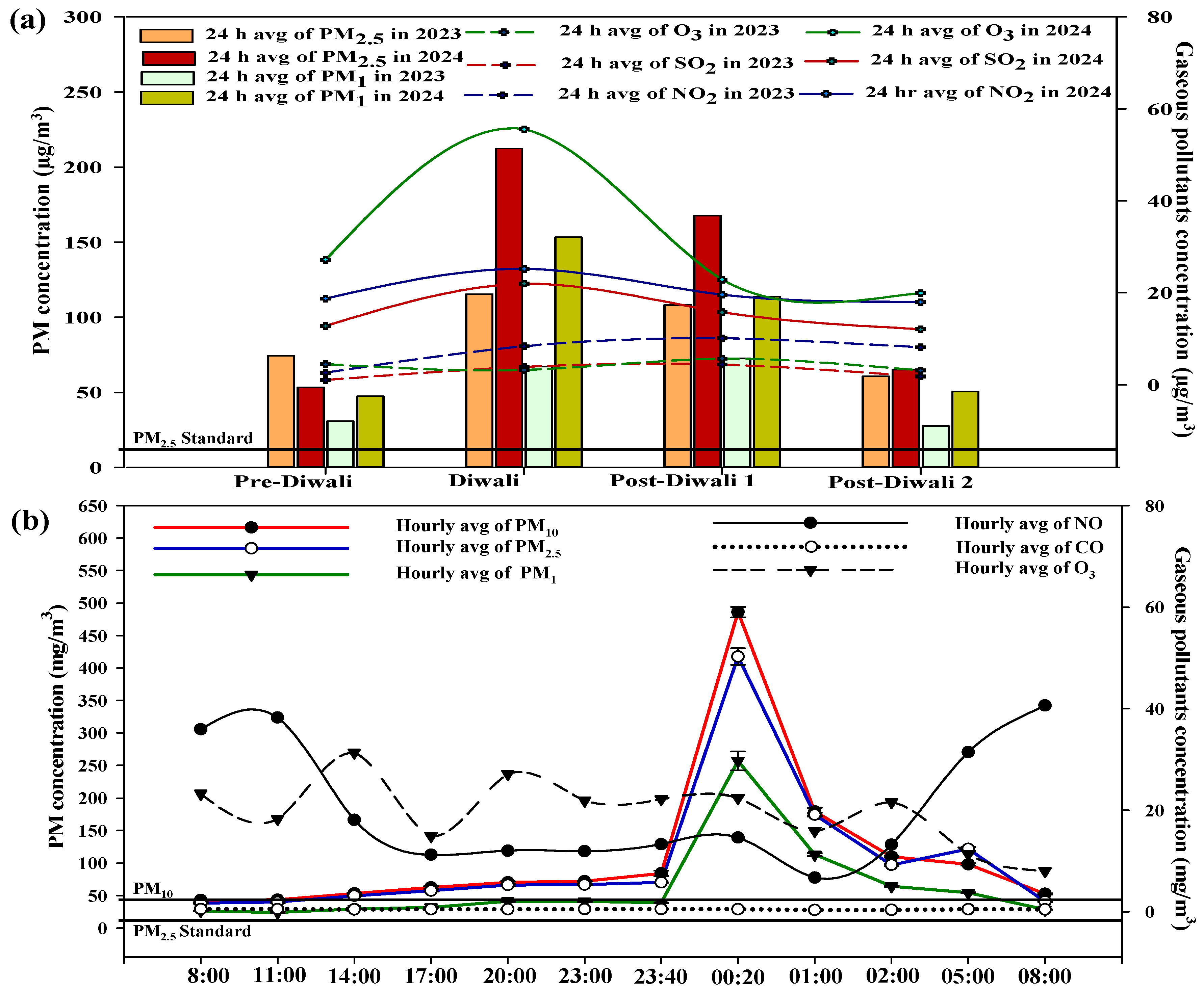
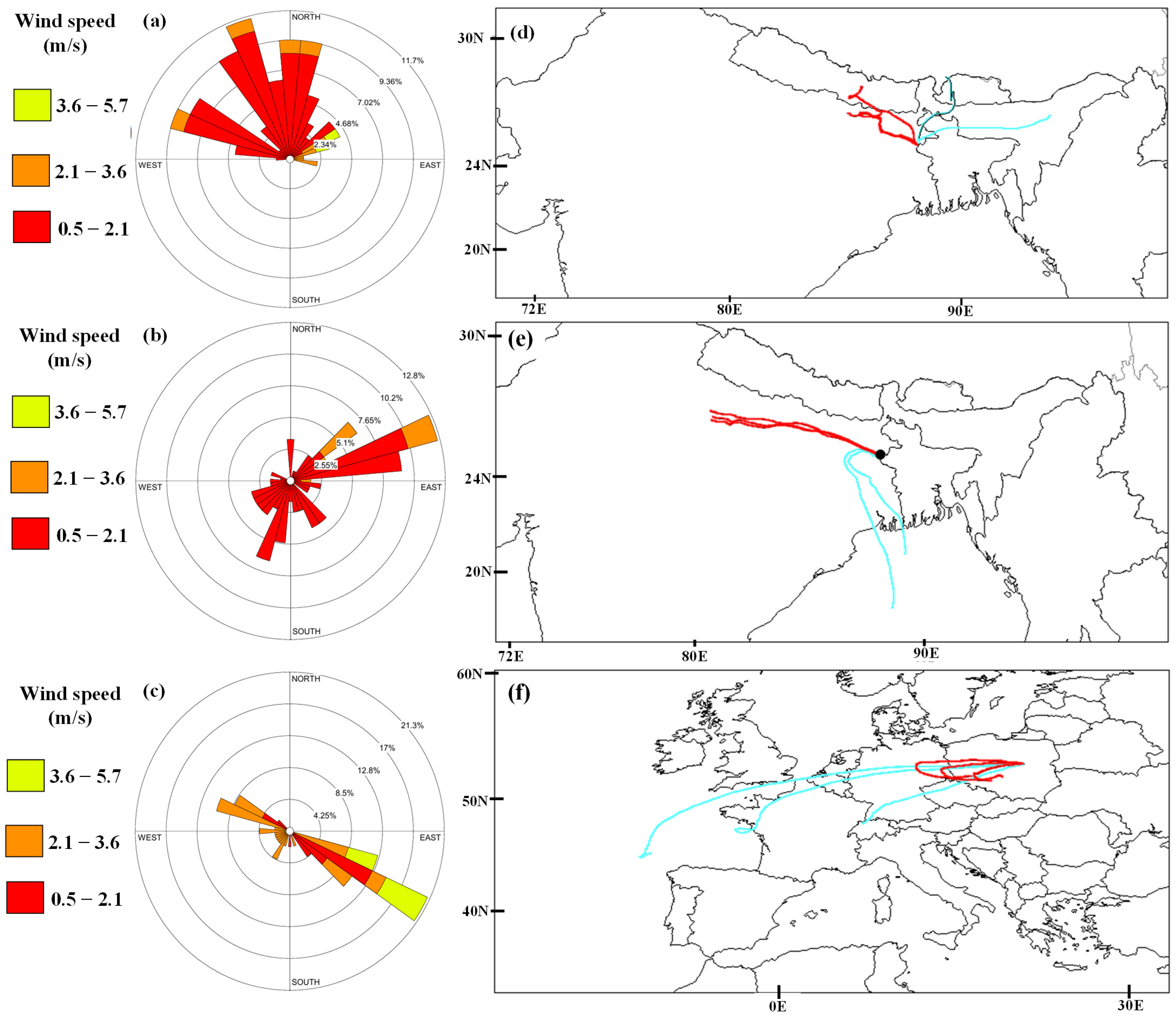
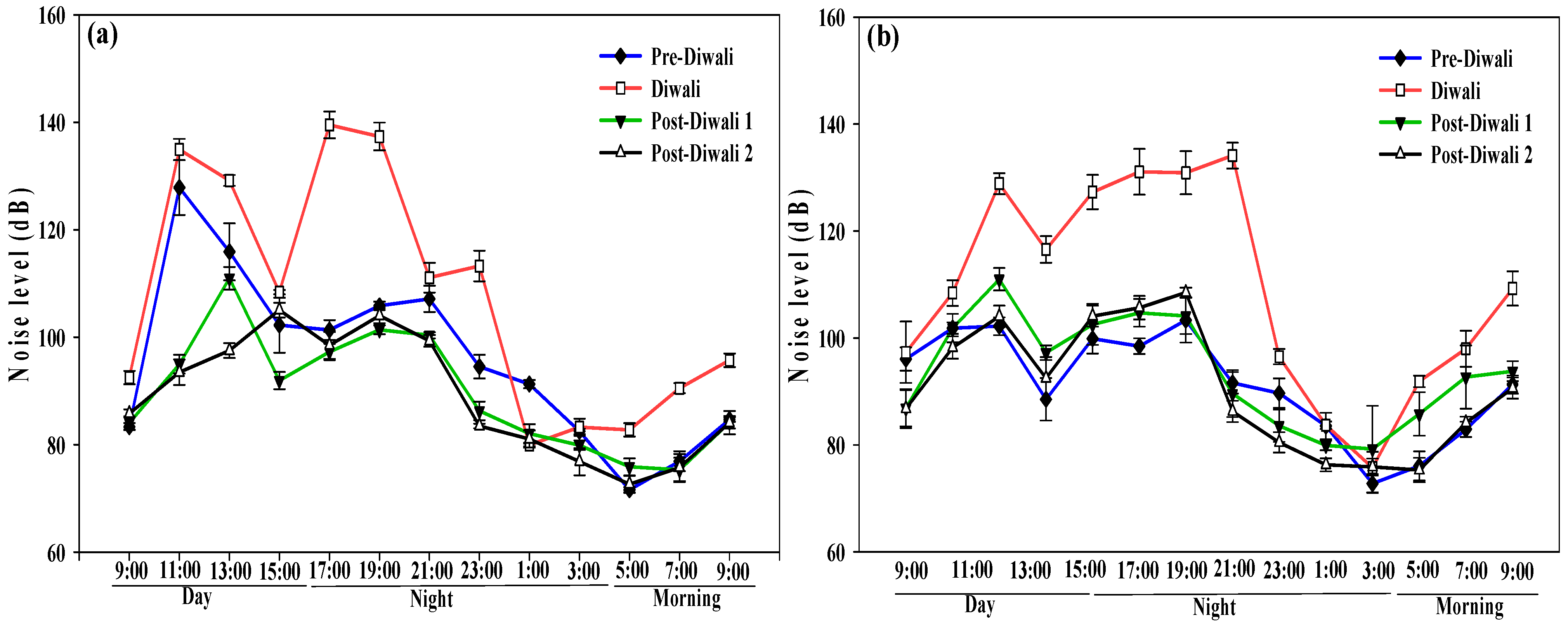
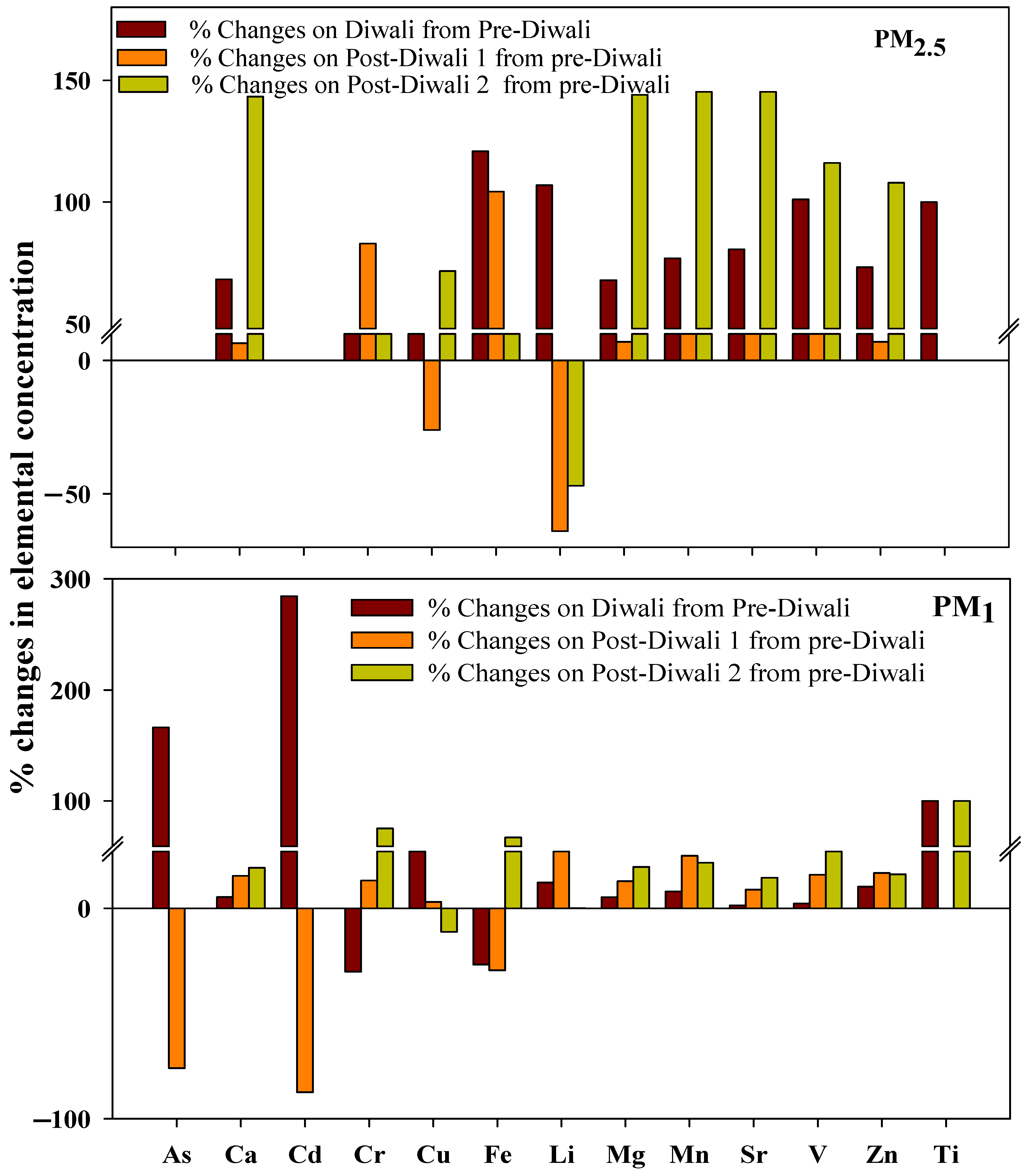
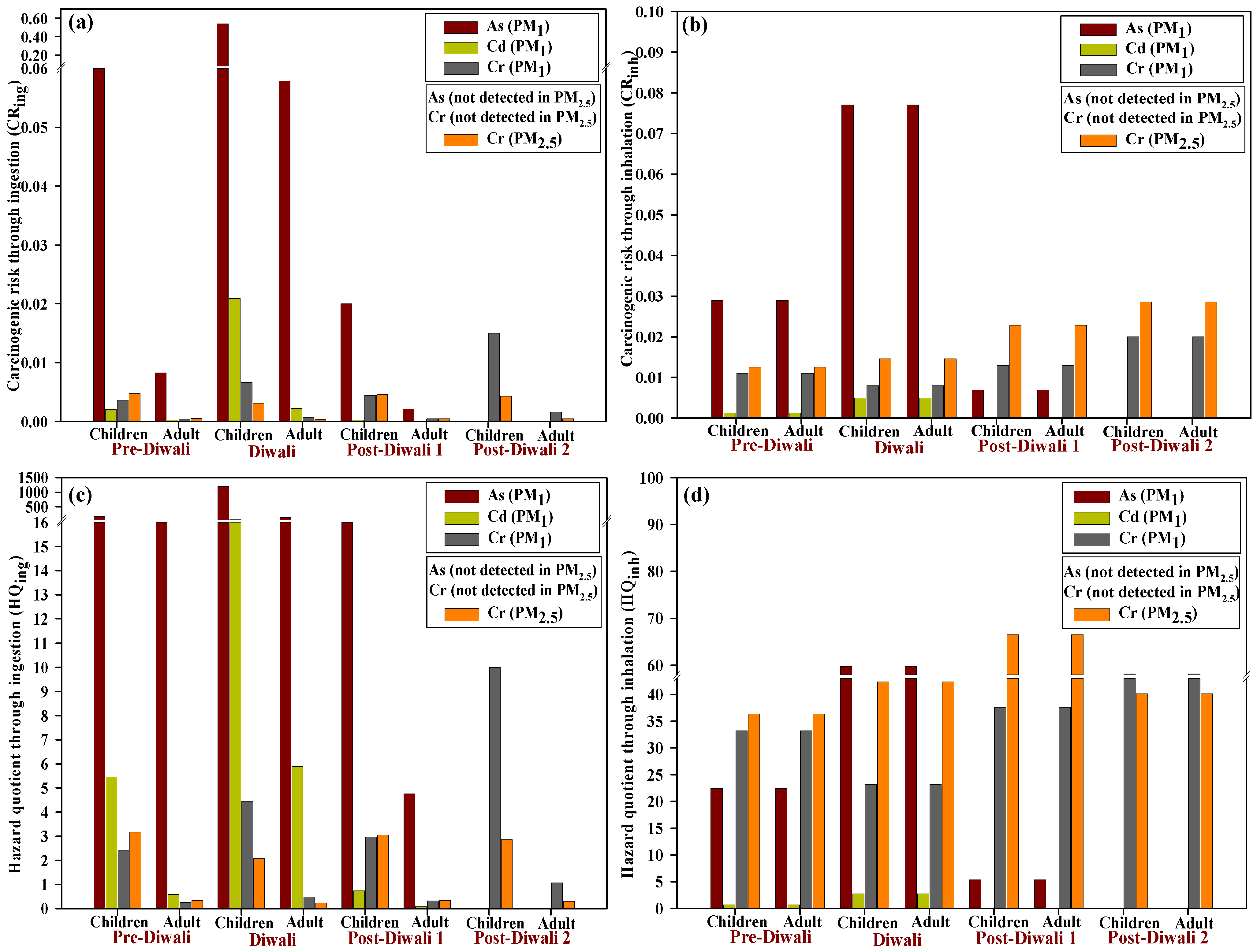
| Monitoring Days | Study Area, Year | Avg. Temperature (°C) | Relative Humidity (%) | Precipitation (mm) | Wind Speed (m/s) |
|---|---|---|---|---|---|
| Pre-Diwali | Malda, West Bengal, India, 2023 | 21.28 | 75.94 | 0 | 1.25 |
| Diwali | 22.37 | 80 | 0 | 1.19 | |
| Post-Diwali 1 | 21.86 | 82.06 | 0 | 1.29 | |
| Post-Diwali 2 | 22.91 | 87.94 | 0 | 1.97 | |
| Pre-Diwali | Malda, West Bengal, India, 2024 | 26.36 | 85.41 | 0.94 | 1.43 |
| Diwali | 25.95 | 82.54 | 0.05 | 1.09 | |
| Post-Diwali 1 | 24.85 | 83.26 | 0 | 0.96 | |
| Post-Diwali 2 | 24.33 | 81.97 | 0 | 1.16 | |
| 31st December | Warsaw, Poland, 2023–2024 | 2.25 | 95.64 | 0.28 | 2.84 |
| 1st January | 1.55 | 97.33 | 10.77 | 1.87 |
| Monitoring Days | Place | AQI Value | AQI Category | Associated Health Impacts |
|---|---|---|---|---|
| Pre Diwali (2023) | Malda, West Bengal, India | 102 | Moderate | Individuals with cardiovascular or lung diseases may feel discomfort in terms of inhalation, particularly children and aged persons. |
| Diwali (2023) | 261 | Poor | Long-term exposure may cause breathing discomfort. Short-term exposure may cause discomfort in individuals with heart disease. | |
| Post-Diwali 1 (2023) | 285 | Poor | Long-term exposure may cause breathing discomfort. Short-term exposure may cause discomfort in individuals with heart disease. | |
| Post-Diwali 2 (2023) | 74 | Satisfactory | Sensitive people may feel breathing discomfort. | |
| Pre Diwali (2023) | Malda, West Bengal, India | 88 | Satisfactory | Sensitive people may feel breathing discomfort. |
| Diwali (2023) | 371 | Very Poor | Prolonged exposure may cause respiratory diseases, especially for people with pre-existing health issues. | |
| Post-Diwali 1 (2023) | 336 | Very Poor | Prolonged exposure may cause respiratory diseases, especially for people with pre-existing health issues. | |
| Post-Diwali 2 (2023) | 117 | Moderate | Individuals with cardiovascular or lung diseases may feel discomfort in terms of inhalation, particularly children and aged persons. | |
| 31 December 2023 (8:00 a.m.) | Warsaw, Poland, Europe | 45 | Good | No or minimal impact |
| 31 December 2023 (11:00 a.m.) | 48 | Good | No or minimal impact | |
| 31 December 2023 (14:00 p.m.) | 53 | Satisfactory | Sensitive people may feel breathing discomfort. | |
| 31 December 2023 (17:00 p.m.) | 63 | Satisfactory | Sensitive people may feel breathing discomfort. | |
| 31 December 2023 (20:00 p.m.) | 70 | Satisfactory | Sensitive people may feel breathing discomfort. | |
| 31 December 2023 (23:00 p.m.) | 72 | Satisfactory | Sensitive people may feel breathing discomfort. | |
| 1 January 2024 (00:20 a.m.) | 470 | Severe | Everyone is likely to be affected, should avoid outdoor activity. | |
| 1 January 2024 (1:00 a.m.) | 153 | Moderate | Individuals with cardiovascular or lung diseases may feel discomfort in terms of inhalation, particularly children and aged persons. | |
| 1 January 2024 (2:00 a.m.) | 107 | Moderate | Individuals with cardiovascular or lung diseases may feel discomfort in terms of inhalation, particularly children and aged persons. | |
| 1 January 2024 (5:00 a.m.) | 98 | Satisfactory | Sensitive people may feel breathing discomfort. | |
| 1 January 2024 (8:00 a.m.) | 53 | Satisfactory | Sensitive people may feel breathing discomfort. |
| Elements | Pre-Diwali | Diwali | Post-Diwali 1 | Post-Diwali 2 | ||||
|---|---|---|---|---|---|---|---|---|
| PM2.5 | PM1 | PM2.5 | PM1 | PM2.5 | PM1 | PM2.5 | PM1 | |
| As | - | 5931.52 | - | 18,071.45 | - | 2017.84 | - | - |
| Ca | 213.33 | 212.38 | 318.52 | 256.19 | 111.22 | 347.67 | 393.06 | 151.79 |
| Cd | - | 6413.05 | - | 28,192.17 | - | 1144.69 | - | - |
| Cr | 38.22 | 51.76 | 39.51 | 41.37 | 34.23 | 83.15 | 31.94 | 54.30 |
| Cu | 283.92 | 494.11 | 328.51 | 740.50 | 369.10 | 722.33 | 102.74 | 262.66 |
| Fe | 1 | 1 | 1 | 1 | 1 | 1 | 1 | 1 |
| Li | 2003.97 | 791.76 | 3679.97 | 1017.06 | 352.78 | 1453.62 | 804.68 | 474.67 |
| Mg | 164.30 | 166.36 | 303.66 | 200.51 | 86.05 | 266.48 | 244.88 | 119.23 |
| Mn | 21.89 | 22.86 | 40.66 | 28.27 | 34.36 | 40.55 | 12.01 | 16.66 |
| Sr | 37.51 | 39.67 | 69.65 | 46.03 | 60.11 | 61.27 | 26.08 | 27.21 |
| V | 248.41 | 215.73 | 443.21 | 252.48 | 137.51 | 354.81 | 406.52 | 192.20 |
| Zn | 276.93 | 321.29 | 425.79 | 405.48 | 145.04 | 532.44 | 436.10 | 223.54 |
| Ti | - | - | 309.29 | 458.80 | - | - | - | 250.13 |
Disclaimer/Publisher’s Note: The statements, opinions and data contained in all publications are solely those of the individual author(s) and contributor(s) and not of MDPI and/or the editor(s). MDPI and/or the editor(s) disclaim responsibility for any injury to people or property resulting from any ideas, methods, instructions or products referred to in the content. |
© 2025 by the authors. Licensee MDPI, Basel, Switzerland. This article is an open access article distributed under the terms and conditions of the Creative Commons Attribution (CC BY) license (https://creativecommons.org/licenses/by/4.0/).
Share and Cite
Roy, A.; Mandal, M.; Binha, S.K.; Prasad, D.; Popek, R.; Przybysz, A.; Sarkar, A. Festive Pollution: A Global Concern—A Comparative Study of Diwali in India and New Year’s Eve in Poland. Atmosphere 2025, 16, 442. https://doi.org/10.3390/atmos16040442
Roy A, Mandal M, Binha SK, Prasad D, Popek R, Przybysz A, Sarkar A. Festive Pollution: A Global Concern—A Comparative Study of Diwali in India and New Year’s Eve in Poland. Atmosphere. 2025; 16(4):442. https://doi.org/10.3390/atmos16040442
Chicago/Turabian StyleRoy, Anamika, Mamun Mandal, Sneha Kumari Binha, Dinesh Prasad, Robert Popek, Arkadiusz Przybysz, and Abhijit Sarkar. 2025. "Festive Pollution: A Global Concern—A Comparative Study of Diwali in India and New Year’s Eve in Poland" Atmosphere 16, no. 4: 442. https://doi.org/10.3390/atmos16040442
APA StyleRoy, A., Mandal, M., Binha, S. K., Prasad, D., Popek, R., Przybysz, A., & Sarkar, A. (2025). Festive Pollution: A Global Concern—A Comparative Study of Diwali in India and New Year’s Eve in Poland. Atmosphere, 16(4), 442. https://doi.org/10.3390/atmos16040442








